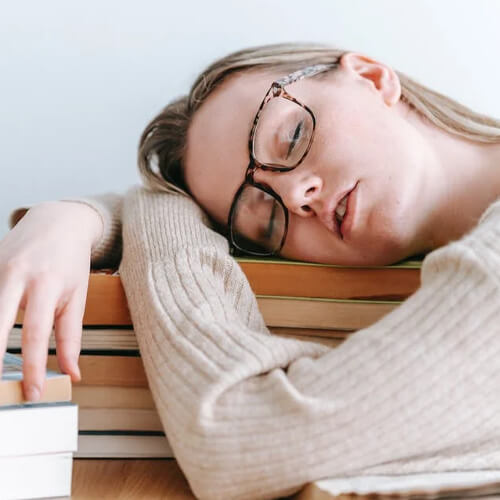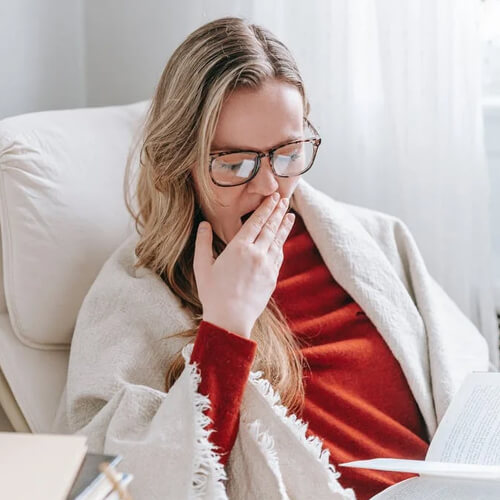For Patients
When a person has obstructive sleep apnea (OSA) their airway collapses multiple times during each hour of sleep, causing the patient to briefly stop breathing. As a result of these lapses in breathing, they are likely to experience snoring, daytime sleepiness, morning headaches, and trouble focusing. Obstructive sleep apnea also comes with an increased risk of other health problems, like stroke and heart attack. Experts estimate that in the U.S., up to 93% of women and 82% of men who have OSA remain undiagnosed.
About Obstructive Sleep Apnea (OSA)
OSA occurs when breathing is interrupted during sleep. Risk factors for sleep apnea include:
- Excessive weight
- Heavy smoking
- Sedative medications
- Pregnancy
- High blood pressure
Left untreated, sleep apnea can lead to serious health problems including high blood pressure, stroke, heart failure, irregular heartbeats and heart attacks.
Your first step is an exam and sleep study
Working seamlessly to deliver sleep solutions

Two types of studies can potentially detect obstructive sleep apnea. The first is an overnight sleep study in a lab or hospital, called polysomnography. The second is a home sleep apnea test. Although a home sleep apnea test does not measure brain waves during sleep, it does measure other factors that can help medical professionals determine if a person has OSA.
Sleep Apnea Symptoms
- Morning headaches
- Forgetfulness
- Forgetfulness
- Mood changes
- Decreased interest in sex
- Spouse complains about your constant snoring
- Frequent nighttime waking
- Waking yourself up with your own snoring
- Waking up with a sore and/or dry throat
- Waking up with a choking or gasping feeling
- Chronic daytime sleepiness
What Is an At-Home Sleep Test?



Home Sleep Studies vs. In-Lab Sleep Studies
Home sleep tests are only used to diagnose sleep-disordered breathing issues, like sleep apnea. By contrast, in-lab sleep studies can help diagnose other sleep disorders, like narcolepsy and periodic limb movement disorders. The difference lies in what the tests measure. Although both tests usually measure factors like airflow, blood oxygen levels, and heart rate, only in-lab sleep studies actually measure sleep by monitoring brain activity.
People often prefer a home sleep study to an in-lab study, since it is less expensive and does not require traveling to the sleep lab. A home sleep apnea test also involves fewer attached devices, so it may feel less invasive. However, since an in-lab sleep study gathers more data, it is more likely to pick up on symptoms of obstructive sleep apnea or other conditions.
If you have a straightforward case of moderate or severe sleep apnea and no other health conditions, then a home sleep apnea test might be right for you. If you have any reason to believe you need a more comprehensive test, then it might be worthwhile to skip the home test and go directly to the sleep lab.
Who Should Not Take a Home Sleep Study?
Although a home sleep test is useful for many people who may have obstructive sleep apnea, certain factors make it less accurate for others. Experts recommend an in-lab sleep study rather than a home study for people who are suspected to have:
- Congestive heart failure
- Severe or chronic pulmonary disease
- Neurological or neuromuscular disorders
- Other sleep disorders, like narcolepsy, parasomnias, or periodic limb movement disorder
A home sleep study may also be less accurate at detecting mild sleep apnea. If your sleep specialist suspects you have mild sleep apnea, they may recommend an in-lab study instead.
Sleep Study
What Is a Sleep Study?
A sleep study is a non-invasive, overnight exam that allows doctors to monitor you while you sleep to see what’s happening in your brain and body. For this test, you will go to a sleep lab that is set up for overnight stays—usually in a hospital or sleep center. While you sleep, an EEG monitors your sleep stages and the cycles of REM and nonREM or NREM sleep you go through during the night, to identify possible disruptions in the pattern of your sleep. A sleep study will also measure things such as eye movements, oxygen levels in your blood (through a sensor—there are no needles involved), heart and breathing rates, snoring, and body movements.
The data from your sleep study will usually be taken by a technologist, and later evaluated by your doctor. This may take up to two weeks, when you’ll schedule a follow up to discuss the results.



Types of Sleep Studies
Sleep studies collect data about what is happening in a person’s body during sleep. Different types of sleep studies are available depending on one’s symptoms and the sleep disorders that may be present.
Continuous positive airway pressure (CPAP) is a common treatment for sleep apnea. In CPAP titration, a technologist determines the amount of air pressure that patient needs from their CPAP so that their machine can be properly programmed for home use. CPAP titration usually requires a second sleep study. When sleep apnea is strongly suspected, a split-night sleep study2 may be an option. In a split-night study, polysomnography is used to diagnose sleep apnea during the first half of the night, and CPAP titration is performed during the second half of the night.
Home sleep apnea testing collects data about a patient’s breathing, heart rate, and other variables overnight. However, compared with polysomnography, home testing provides less information, and the process is not overseen by a technologist.
What Can a Sleep Study Diagnose?
A sleep study is used to diagnose many sleep disorders, including:
- Insomnia
- Sleep Apnea
- Restless Leg Syndrome
- Narcolepsy
- Periodic Limb Movement Disorder
- Sleepwalking
- Sleep Talking (Somniloquy)
- REM Sleep Behavior Disorder
Who Needs a Sleep Study?
When you visit a clinic for polysomnography, you will be assigned a room to yourself. Before bedtime, a technologist glues or tapes painless sensors to your head and body that will record information. If you need to use the bathroom, the technologist will detach the sensors and reattach them when you return.
You can read and relax in bed until it is time to go to sleep. The technologist will be on hand to monitor and record the results of your test and to assist you with any issues during the night. The sleep test ends when you wake up in the morning and have the sensors removed.
